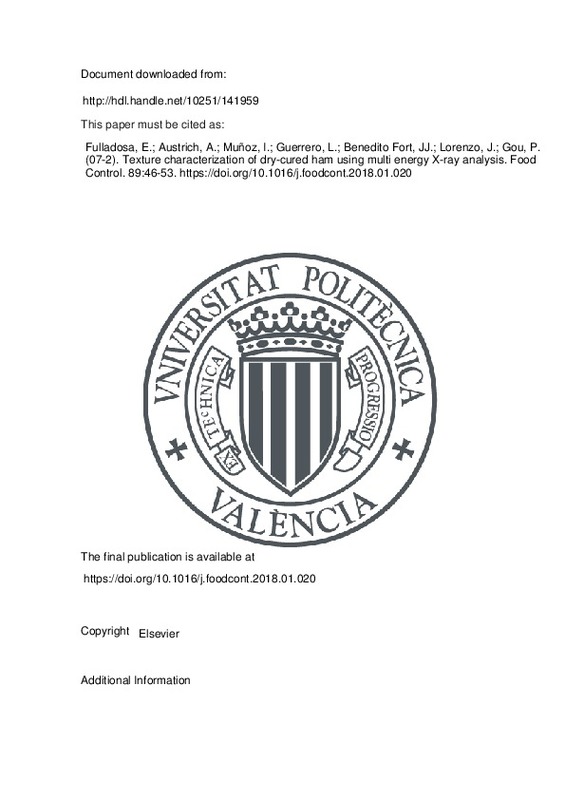JavaScript is disabled for your browser. Some features of this site may not work without it.
Buscar en RiuNet
Listar
Mi cuenta
Estadísticas
Ayuda RiuNet
Admin. UPV
Texture characterization of dry-cured ham using multi energy X-ray analysis
Mostrar el registro sencillo del ítem
Ficheros en el ítem
| dc.contributor.author | Fulladosa, E.
|
es_ES |
| dc.contributor.author | Austrich, A.
|
es_ES |
| dc.contributor.author | Muñoz, I
|
es_ES |
| dc.contributor.author | Guerrero, L.
|
es_ES |
| dc.contributor.author | Benedito Fort, José Javier
|
es_ES |
| dc.contributor.author | Lorenzo, J.M
|
es_ES |
| dc.contributor.author | Gou, P.
|
es_ES |
| dc.date.accessioned | 2020-04-29T07:04:52Z | |
| dc.date.available | 2020-04-29T07:04:52Z | |
| dc.date.issued | 2018-07 | es_ES |
| dc.identifier.issn | 0956-7135 | es_ES |
| dc.identifier.uri | http://hdl.handle.net/10251/141959 | |
| dc.description.abstract | [EN] Multi energy X-ray sensors are able to differentiate and quantify X-rays of different energies. In contrast to conventional sensors, which simply record the overall energy of the X-rays whatever the energy of x-rays is, multi energy sensors provides a spectrum of the X-rays energies, which may be differently attenuated. In this study, the feasibility of this technology to detect changes in dry-cured ham slices after inducing proteolysis was evaluated. Effect of salt and water contents on the attenuation was also studied. In addition, the classification of commercial samples according to their proteolysis index was assessed. Results showed a decrease of attenuation for increasing proteolysis induction times (p < 0.01) for all the regions of the spectrum (energy bands), but not with the same intensity, at any of the analysed acquisition conditions. Salt and water contents produced a significant (p < 0.01) effect on the attenuation. Influence of salt content was higher than that of water content, and both affected the prediction of the proteolysis index. Classification score of commercial samples exhibited a limited discrimination capacity, showing the need for more sophisticated data analysis. (C) 2018 Elsevier Ltd. All rights reserved. | es_ES |
| dc.description.sponsorship | This work was partially supported by INIA (contract n. RTA201300030-0O3-01), Ministerio de Economia y Competitividad (PEJ2014-A34573) and CERCA programme from Generalitat de Catalunya. | es_ES |
| dc.language | Inglés | es_ES |
| dc.publisher | Elsevier | es_ES |
| dc.relation.ispartof | Food Control | es_ES |
| dc.rights | Reconocimiento - No comercial - Sin obra derivada (by-nc-nd) | es_ES |
| dc.subject | Non-destructive | es_ES |
| dc.subject | Quality evaluation | es_ES |
| dc.subject | Proteolysis | es_ES |
| dc.subject | Spectrometry | es_ES |
| dc.subject.classification | TECNOLOGIA DE ALIMENTOS | es_ES |
| dc.title | Texture characterization of dry-cured ham using multi energy X-ray analysis | es_ES |
| dc.type | Artículo | es_ES |
| dc.identifier.doi | 10.1016/j.foodcont.2018.01.020 | es_ES |
| dc.relation.projectID | info:eu-repo/grantAgreement/MINECO//PEJ-2014-A-34573/ | es_ES |
| dc.relation.projectID | info:eu-repo/grantAgreement/MINECO//RTA2013-00030-C03-02/ES/Caracterización y detección objetiva de defectos de textura en jamón curado mediante tecnologías no destructivas. Desarrollo y evaluación de medidas correctoras/ | es_ES |
| dc.rights.accessRights | Abierto | es_ES |
| dc.contributor.affiliation | Universitat Politècnica de València. Departamento de Tecnología de Alimentos - Departament de Tecnologia d'Aliments | es_ES |
| dc.description.bibliographicCitation | Fulladosa, E.; Austrich, A.; Muñoz, I.; Guerrero, L.; Benedito Fort, JJ.; Lorenzo, J.; Gou, P. (2018). Texture characterization of dry-cured ham using multi energy X-ray analysis. Food Control. 89:46-53. https://doi.org/10.1016/j.foodcont.2018.01.020 | es_ES |
| dc.description.accrualMethod | S | es_ES |
| dc.relation.publisherversion | https://doi.org/10.1016/j.foodcont.2018.01.020 | es_ES |
| dc.description.upvformatpinicio | 46 | es_ES |
| dc.description.upvformatpfin | 53 | es_ES |
| dc.type.version | info:eu-repo/semantics/publishedVersion | es_ES |
| dc.description.volume | 89 | es_ES |
| dc.relation.pasarela | S\353196 | es_ES |
| dc.contributor.funder | Centres de Recerca de Catalunya | es_ES |
| dc.contributor.funder | Ministerio de Economía y Competitividad | es_ES |







![[Cerrado]](/themes/UPV/images/candado.png)

